
EN USER GUIDE
MICROWAVE COMBI OVEN

2
•
1
2
A
B
C
D
1
2

3
•
1
2
s
•
2
E
A
B
C

4
•
2
•
3
D
E
F
A

5
•
3
B
C
D
E

6
•
3
G
H
F

7
DEAR CUSTOMER,
EN
Discovering a De Dietrich product means experiencing the range of unique
emotions.
The attraction is immediate, from the moment you set eyes on the product.
The sheer quality of the design
shines through, thanks to the timeless style and outstanding finishes which
make each component an elegant and refined masterpiece in its own right,
each one
in perfect harmony with the others. Next, comes the irresistible urge to
touch it.
De Dietrich design makes extensive use of robust and prestigious
materials, where the accent is place firmly upon authenticity. By combining
state-of-the-art technology
with top quality materials, De Dietrich produces
beautifully crafted products to help you get the most from the culinary arts,
a passion
shared by all lovers of cooking and fine food. We hope that you enjoy
using this new appliance.
Thank you for choosing a De Dietrich product.

8
CONTENTS
EN
1 / DESCRIPTION OF THE OVEN
• Presentation of your oven ...................................................................... 2
• Description of controls..............................................................................9
• Description of accessories ......................................................................10
2 / SETTING
• Setting the clock ......................................................................................11
• Changing the clock ..................................................................................11
• Minute Minder ..........................................................................................11
• Locking the controls ................................................................................11
• Settings menu ..........................................................................................11
• Controlling the turntable ..........................................................................11
3 / USE
• Cooking modes ........................................................................................12
• Immediate cooking ..................................................................................14
º Changing the temperature ................................................................14
º Changing the power ..........................................................................14
º Programming the time........................................................................14
º Delayed start time ..............................................................................14
º Automatic cooking functions ..................................................................14
º Automatic defrosting functions .............................................................. 15
º Memorise a cooking mode ......................................................................15
4 / CARE
º External surface ................................................................................15
º Changing the lamp ............................................................................15
5 / ANOMALIES AND SOLUTIONS ................................................................16
6 / AFTER-SALES SERVICE
• Customer relations....................................................................................16
• Servicing and Repairs, France ................................................................16
7 / FUNCTION SUITABILITY TESTS ..............................................................17

9
•
1DESCRIPTION OF THE OVEN
1- Cooking modes display
2- Oven temperature and clock display
3- End of cooking time indicator
4- Cooking time indicator
5-Stopping the turntable
6- Power/weight indicator
7- Shelf runner indicator
BUTTONS
•
This is a rotating knob with central button to choose programmes, increase or reduce
values and confirm.
The drawings on the control knob are symbolised as follows:
CONTROL KNOB
•
PRESS the centre of the
knob to confirm.
TURN the knob.
CONTROL PANEL
THE DISPLAY
•
1
Control locking indicator
“Recipes” function indicator
Cooking time indicator
Minute minder indicator
Cooking end indicator
On/Off
Adjusting the temperature
and power
Adjusting the clock, the time and the
end of cooking, the minute minder
Access the settings MENU
1
2
3
4
1
3
7
5
6
4
2
1
2
3
4

10
•
1DESCRIPTION OF THE OVEN
ACCESSORIES
Anti-tip safety rack (fig. A).
This allows you to toast, brown or grill.
The rack should never be used with other
metal cookware on the microwave, grill +
microwave or forced air + microwave
modes.
However, you can reheat food in an alumi-
nium tray providing this is isolated from the
rack using a plate.
The glass drip tray (fig. B).
This can be used half-filled with water for
double-boiler cooking methods in
fan cooking. It can be used as a cooking
dish.
Note:
Take care to place the drip tray in the
centre of the side racks to avoid affecting
air circulation.
Rack + glass drip tray (fig.C)
to roast and retain the cooking juices, place
the rack on the drip tray.
The shelf supports (fig.D)
2 hanging supports allow you to use the rack
at three heights.
The turntable (fig.E)
The turntable ensures equal cooking of
food throughout with no need to intervene.
It rotates in both directions. If it does not
turn, verify that all components are pro-
perly positioned.
It may be used as a cooking dish. For
easy removal, wells are provided on ei-
ther side.
Rotation is controlled by the drive shaft
and the wheel support.
If you take out the support with the drive
spindle, make sure you do not let water
get into the motor spindle orifice.
Remember to put back the support, the
support wheels and the glass turntable.
Do not try to rotate the glass turntable ma-
nually, as you could damage the drive sys-
tem. If it does not turn smoothly, make sure
that there is nothing in the well beneath the
turntable.
When the turntable is in the stop position,
large dishes can be used which cover the
entire surface of the oven. In this case, it is
necessary to turn the container or to mix its
content half-way through the programme.
OPERATING PRINCIPLE
The microwaves used for cooking are elec-
tromagnetic waves. They are commonly
found in our environment in the form of radio
waves, light and infrared rays.
Their frequency is in the 2450 MHz range.
Their behaviour:
· They are reflected by metals.
· They travel through all other materials.
· They are absorbed by water, fat and
sugar molecules.
When food is exposed to microwaves its mo-
lecules begin moving rapidly, causing it to
heat up. The penetration depth of waves into
the food is approximately 2.5 cm; if the food
is thicker, the centre of the food will be coo-
ked by conduction, as in conventional coo-
king.
Note that microwaves cause a simple ther-
mal phenomenon within food and are not
harmful to health.
2

11
SETTING THE CLOCK (fig. A)
When switching on, the display flashes at
12:00.
Adjust the time by turning the dial then
press to validate.
If there is a power cut, the clock flashes.
CHANGING THE CLOCK (fig. B)
Press the button for a few seconds until
the clock flashes. Adjust the clock by
turning the knob and then press to confirm.
MINUTE MINDER (fig. C)
This function can only be used when the
oven is off.
Press .
00:00 flashes. Set the minute minder by
turning the knob and then press to confirm.
The timer starts.
Once the time has lapsed, there is a sound
signal. To stop it, press any key.
NB: NB: You can modify or cancel the
timer at any time.
To cancel, return to the timer’s menu
and set to 00:00.
CONTROL LOCKING Child safety (fig.
D)
Press and at the same time until the
symbol appears on the screen. Control
locking is accessible during cooking or
when the oven has stopped.
N.B.:only the button remains active
during cooking.
To unlock the keypad, press and to-
gether until the symbol disappears off
the screen.
SETTINGS MENU (fig. E)
You can adjust different settings on your
oven:
light, contrast, sounds and demo mode.
To do this, press for a few seconds to
access the settings menu.
See the table below:
To modify the different settings if neces-
sary, turn the control knob and then press
to confirm.
To come out of the settings menu at any
time, press .
CONTROLLING THE TURNTABLE
(fig.F)
If you think that there is not enough space
for it to rotate freely in the oven, you can
stop the turntable before or during the pro-
gramme.
- Press the and buttons at the same
time for a few seconds.
The symbol appears in the display.
• Restarting the turntable
Press and hold the and buttons si-
multaneously for a few seconds until the
symbol appears in the display.
•
2SETTINGS
Default
settings
Sounds - beeps:
Position ON, sounds active.
Position OFF, no sounds.
Contrast:
The brightness of the
display is adjustable from
20 to 100%.
DEMO mode:
Position ON, mode active.
Position OFF, normal mode.

12
Microwave
Position
Use
Power
•
3USE
MICROWAVE FUNCTIONS
Microwave
Quick reheating drinks, water and dishes that
contain a large quantity of liquid.
Cooking food that contains a lot of water
(soups, sauces, tomatoes, etc.).
1000W
Cooking fresh or frozen vegetables.
800W / 900W
Microwave
Melting chocolate.
600W
Microwave
Cooking fish and seafood. Heating on 2
levels.
Cooking dry vegetables over a low heat.
Reheating or cooking fragile egg-based
foods.
500W
Microwave
Cooking dairy products and jam at low heat.
400W /
300W
Microwave
Manual defrost. Softening butter and ice
cream.
200W
Microwave
Defrosting pastries that contain cream.
100W
Defrosting
200W
COOKING
This oven allows you to access 4 different types of cooking mode:
- The Microwave function
- The combined microwave functions (microwave + Traditional cooking).
- The traditional cooking functions.
- The Automatic cooking functions.

13
Fan cooking + mi-
crowave
This function combines microwave
cooking with fan cooking to save you a
considerable amount of time.
Recommended for meat, chicken and
roasts placed in a dish.
Medium grill + mi-
crowave
This function lets you use the grill and the
micro-wave simultaneously, which makes
cooking very quick.
This function lets you cook and brown
foods such as gratin dishes and meats.
It can be used before or after cooking, de-
pending on the recipe.
2
1-4
Full grill + micro-
wave
Cooking in full grill + microwave to grill
meat and fish.
4
1-4
Position
Use
Recommended T°C
and power mini - maxi
•
3USE
COMBINED MICROWAVE FUNCTIONS
200°C
50°C - 200°C
300W
100W - 300W
300W
100W -
700W
300W
100W - 700W
Position
Use
T°C recommended
mini - maxi
TRADITIONAL COOKING FUNCTIONS
Full grill
Recommended for grilling cutlets, sausages,
toasting bread and prawns placed on the grill.
2
1 - 4
Pulsed full grill
Roasts and poultry are juicy and crisp all
over.
To retain the moist texture of fish steaks.
200°C
50°C - 200°C
Fan
cooking*
Recommended for keeping white meat, fish
and vegetables moist.
200°C
50°C - 220°C

14
IMMEDIATE COOKING (fig.A)
The programmer must only display the
time. It should not be flashing.
Turn the control knob until you get to the
cooking function of your choose, then
confirm.
MODIFY THE TEMPERATURE (fig.B)
- Press the key, the Temperature flashes,
you may adjust it.
Adjust the temperature by turning the knob
and then press to confirm.
- Example: 180°C.
MODIFY THE POWER (fig.C)
- Press the key, the power (300W)
flashes, you may adjust it.
- Set the power, using the knob.
- Example: 200 Watts.
Confirm by pressing the knob.
PROGRAMMING THE COOKING TIME
(fig. D)
Use the immediate cooking programme,
then press ; the cooking time flashes
and it is now possible to set it.
Turn the knob to adjust the cooking time.
Press to confirm.
Your oven has the “SMART ASSIST” func-
tion which, when programming a cooking
time, will suggest a cooking time which can
be modified depending on the selected
cooking mode.
The cooking time is saved automatically
after a few seconds.
NB: Halfway through the cooking time,
the oven beeps and displays «TURN» to
tell you to turn your food over.
DELAYED START (fig. E)
Proceed as for programmed cooking.
After setting the cooking time, press .
The display flashes. Set the cooking end
time by turning the knob. The cooking end
time is automatically saved after a few se-
conds. The cooking end time display
stops flashing.
THE AUTOMATIC COOKING FUNC-
TIONS (fig. F)
Programming automatic cooking by weight
or time selects the cooking settings for you.
The programmer must only display the
time. It should not be flashing.
Select mode using the knob.
The logo flashes.
- Select an
AUTOMATIC cooking mode (See table)
- A suggested weight flashes on the screen.
- Example: P3 —> weight, 500G.
-Adjust the weight or time using the knob.
•
3
USE
Food
14
Recipes
Fibrous fresh vegetables
P01
Fresh vegetables
P02
Frozen vegetables
P03
Poultry (combined function)
P04
Beef (combined function)
P05
Fish
P06
Fresh pizza (combined function)
P07
Frozen pizza (combined function)
P08
Frozen pizza (Traditional cooking)
P09
Prepared fresh meal (Microwave)
P10
Prepared frozen meal
P11
Prepared fresh meal (combined
function)
P12
Savoury tart
P13
Potato gratin quiche
P14

15
Example: 650g.
- Confirm by pressing the knob once.
-The icon of the cooking mode used and
the time calculated automatically are dis-
played. The oven starts.
Select a pre-programmed food.
THE AUTOMATIC
DEFROSTING FUNCTIONS
This oven allows you to access 3 different
types of programmes in the defrost mode
- Automatic defrost P1, P2 or P3.
You simply select the type of programme
and enter the weight.
P1: The automatic defrost mode for meat,
poultry and ready-made meals.
P2: The automatic defrost mode for fish.
P3: The automatic defrost mode for bread
and pastries.
NB: A delayed start cannot be pro-
grammed for defrost functions.
MEMORISE A COOKING MODE
You can memorise 3 cooking programmes
of your choice that may be used later.
- Programme a memory
(fig. G) :
Select a cooking mode, its power or its
temperature and then press the knob until
you get to «MEM 1». Choose one of the 3
memories by turning the control knob and
confirm to memorise it. Confirm again to
start cooking.
NB: If the 3 memories are saved, any
new memorisation will replace the pre-
vious one.
A delayed start cannot be programmed
for memorisations.
- Select one of the 3 memories already
saved (fig.H) :
Turn the knob and go to MEMO, then
confirm. Scroll through the memories with
the knob and confirm the one you want.
Cooking starts.
Note:
To stop the oven at any time, hold
down the key.
To pause the cooking in progress, press
the knob.
•
3USE
•
4CARE
EXTERNAL SURFACE
Use a window washing product applied to
a soft cloth. Do not use abrasive creams or
scouring sponges.
Warning
Do not use scouring products, abra-
sive sponges or metal scrapers to clean
the glass oven door as this could
scratch the surface and cause the glass
to shatter.
REPLACING THE LAMP
For all operations on the lamp, contact the
After Sales Department or a qualified profes-
sional accredited to work on the brand.

16
•
6AFTER-SALES SERVICE
SERVICING AND REPAIRS
Any repairs to your appliance must be made
by a qualified professional accredited to work
on the brand. When calling, please provide the
full references of your appliance (commercial
reference, service reference, serial number), so
that we can handle your call better. This infor-
mation appears on the manufacturer’s name-
plate on the equipment.
GENUINE PARTS
When having work carried out, insist on the use of
genuine, certified spare parts only.
You may resolve certain little problems yourself:
The oven is not heating. Check that the oven is correctly connected and that your installa-
tion’s fuse is not out of service. Increase the selected temperature. Check that the oven is not
set to DEMOmode.
The oven light is not working. Replace the bulb or the fuse. Check that the oven is correctly
connected.
The cooling fan continues to operate after the oven stops. This is normal; the fan may
continue running until a maximum of 1 hour after cooking to lower the temperature inside and
outside the oven.
•
5ANOMALIES AND SOLUTIONS

17
•
7FUNCTION SUITABILITYA TESTS
Test Load Approx.
time
Power level se-
lector
Cookware/Tips
Custard
(12.3.1)
1000 g 16 - 18 min 500 W
Pyrex 227
On the turntable
Savoie cake
(12.3.2)
475 g 6 - 7 min 700 W Pyrex 827
On the turntable
Meatloaf
(12.3.3)
900 g 14 min 700 W
Pyrex 838
Cover with plastic
film.
On the turntable
Defrosting
meat
(13.3)
500 g 11 - 12 min 200 W
On a flat plate
On the turntable
Defrosting ras-
pberries
(B.2.1)
250 g 6 - 7 min 200 W
On a flat plate
On the turntable
Potato
gratin
(12.3.4)
1100 g 23 - 25 min
Low grill
+ 700 W
Pyrex 827
On the turntable
Chicken
(12.3.6)
1200 g
24 - 26 min
Full grill
+ 500 W
Place on the grill assembly
+ drip tray
Insert the dish at level 1
from the bottom
Turn midway through
35 - 40 min
Fan cooking
200°C
+ 200 W
In an enamelled earthen-
ware dish
Place on the rack
at level 1 from the bottom
Cake
(12.3.5)
700 g 20 min
Fan cooking
220°C + 200 W
Pyrex 828
Place on the rack at level 1
Functional suitability tests in accordance with IEC/EN/NF EN 60705 standards.
The International Electrotechnical Commission, SC.59K, has established a standard for
comparative performance tests conducted on various micro-wave ovens. We recommend
the following for this appliance:


CZ5703120-01
-
 1
1
-
 2
2
-
 3
3
-
 4
4
-
 5
5
-
 6
6
-
 7
7
-
 8
8
-
 9
9
-
 10
10
-
 11
11
-
 12
12
-
 13
13
-
 14
14
-
 15
15
-
 16
16
-
 17
17
-
 18
18
-
 19
19
De Dietrich DKC7340A User manual
- Type
- User manual
Ask a question and I''ll find the answer in the document
Finding information in a document is now easier with AI
Related papers
-
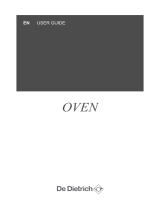 De Dietrich DKE7335W Owner's manual
De Dietrich DKE7335W Owner's manual
-
De Dietrich DKE7335A Owner's manual
-
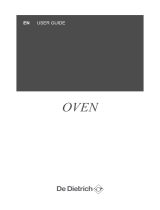 De Dietrich DKE7335W Operating instructions
De Dietrich DKE7335W Operating instructions
-
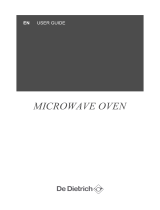 De Dietrich DKE7335X Operating instructions
De Dietrich DKE7335X Operating instructions
-
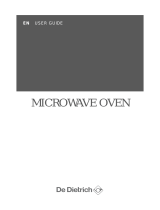 De Dietrich DKE7220X Owner's manual
De Dietrich DKE7220X Owner's manual
-
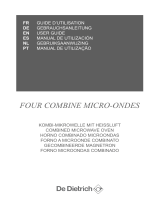 De Dietrich DKC7340W Important information
De Dietrich DKC7340W Important information
-
De Dietrich MWB-580BTCX Owner's manual
-
De Dietrich DHD516XE1 Owner's manual
-
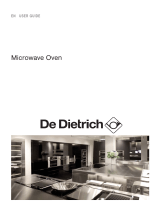 De Dietrich DCI1280X Owner's manual
De Dietrich DCI1280X Owner's manual
-
De Dietrich DHD1122G Owner's manual
Other documents
-
DeDietrich DME1140B User manual
-
Brandt BKC7153BB Owner's manual
-
Ariston Built-in oven Instructions For Use Manual
-
Groupe Brandt 6H-570BTCX Owner's manual
-
Groupe Brandt ME1155XCN Owner's manual
-
Groupe Brandt ME1045M Owner's manual
-
Groupe Brandt ME1255X Owner's manual
-
Groupe Brandt ME1055X Owner's manual
-
Groupe Brandt ME1245X Owner's manual
-
Brandt ME1245X User manual
























